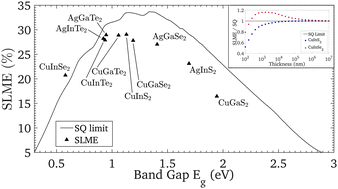First-principles analysis of the spectroscopic limited maximum efficiency of photovoltaic absorber layers for CuAu-like chalcogenides and silicon†
Abstract
Chalcopyrite semiconductors are of considerable interest for application as absorber layers in thin-film photovoltaic cells. When growing films of these compounds, however, they are often found to contain CuAu-like domains, a metastable phase of chalcopyrite. It has been reported that for CuInS2, the presence of the CuAu-like phase improves the short circuit current of the chalcopyrite-based photovoltaic cell. We investigate the thermodynamic stability of both phases for a selected list of I–III–VI2 materials using a first-principles density functional theory approach. For the CuIn–VI2 compounds, the difference in formation energy between the chalcopyrite and CuAu-like phase is found to be close to 2 meV per atom, indicating a high likelihood of the presence of CuAu-like domains. Next, we calculate the spectroscopic limited maximum efficiency (SLME) of the CuAu-like phase and compare the results with those of the corresponding chalcopyrite phase. We identify several candidates with a high efficiency, such as CuAu-like CuInS2, for which we obtain an SLME of 29% at a thickness of 500 nm. We observe that the SLME can have values above the Shockley–Queisser (SQ) limit, and show that this can occur because the SQ limit assumes the absorptivity to be a step function, thus overestimating the radiative recombination in the detailed balance approach. This means that it is possible to find higher theoretical efficiencies within this framework simply by calculating the J–V characteristic with an absorption spectrum. Finally, we expand our SLME analysis to indirect band gap absorbers by studying silicon, and find that the SLME quickly overestimates the reverse saturation current of indirect band gap materials, drastically lowering their calculated efficiency.



 Please wait while we load your content...
Please wait while we load your content...